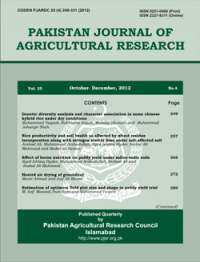EVALUATION OF DIFFERENT PEA (PISUM SATIVUM L.) GENOTYPES FOR YIELD AND OTHER ATTRIBUTES AT SHINKIARI, MANSEHRA
Basharat Hussain Shah*, F. S. Hamid*, Shams ul Islam*, Fayaz Ahmad*, Sohail Aslam*, and Noorullah Khan*
ABSTRACT
The present research work was designed to find out the amount of genetic variability that may exist in different pea cultivars. For this purpose six advance lines/commercial pea varieties were collected from Ayub Agricultural Research Institute (AARI) Faisalabad and one local variety was included in the experiment as a control. The experiment was conducted during 2014-15 at National Tea & High Value Crops Research Institute (NTHRI) Shinkiari, Mansehra. Altogether seven pea genotypes were laid out in Randomized Complete Block Design (RCBD) with three replications. Normal agronomic practices were carried out during the growth period and data was recorded on different growth parameters. Significant differences were observed for all the agronomic traits studied. Root rot attack was observed during the growth period. Pea variety 'Meteor' was found susceptible against this disease followed by 'Sarsabz 9800-1' as moderately susceptible and 9375 as resistant. The other varieties/lines Pea-09, Climax, Local and PF-400 were found tolerant against this disease. Green pod yield per hectare data revealed that pea variety 'Climax' produced the highest yield (11.6 t ha-1) followed by advance lines PF-400 (11.5 t ha-1) and 9375 (9.9 t ha-1), respectively. The lowest yield (2.1 t ha-1) was recorded for 'Meteor' which was also found susceptible against root rot disease. Based on our findings, it is recommended that pea variety 'Climax' cultivation should be promoted in the area at large scale in order to increase the production and give more financial benefits to the farmers of the area. Advance lines PF-400 & 9375 which performed well in the experiment and bear bright future prospects should be considered in designing future hybridization programs.
To share on other social networks, click on any share button. What are these?






